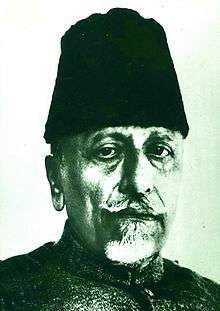Indian provincial elections, 1946
| | ||||||||||||||||||||||||||
| ||||||||||||||||||||||||||
| ||||||||||||||||||||||||||
Provincial elections were held in British India in January 1946 to elect members of the legislative councils of British Indian provinces.[1] The elections were extremely influential in the creation of Pakistan. The Muslim League finished second, but had united the Muslim vote. It won nearly 1/3 of India, as such it gained the negotiating power to begin partitioning India. This was done as it became evident that a united India would be extremely unstable, given that the Muslim League won the majority in Punjab but was prevented from forming a coalition government by Congress and the Unionists, the Pro-Union coalition collapsed as soon as it was formed. This proved a nail in the coffin for Gandhi and Nehru in proving that a united India would be a stable India [2]
Background
On 19 September 1945, the Viceroy Lord Wavell announced that elections to the provincial and central legislatures would be held in December 1945 to January 1946. It was also announced that an executive council would be formed and a constitution-making body would be convened after these elections.[1][3]
These elections were important as the provincial assemblies thus formed were to then elect a new Constituent Assembly for an independent India.
Results
The results were in favour of the Indian National Congress. Of the total of 1585 seats, it won 923 (58.23%). The All-India Muslim League won 425 seats (26.81% of the total), placing it as second-ranking party. The Congress formed its ministries in Assam, Bihar, Bombay, Central Provinces, Madras, NWFP, Orissa and United Provinces. The Muslim League formed its ministries in Bengal and Sind. A coalition consisting of the Congress, Unionist Party and the Akalis was formed in Punjab.[4]
The Communist Party of India had presented 108 candidates, out of whom only 8 won a seat.[5] The set-back came as a result of the decision of the party not to support the Quit India movement of 1942.[6] Seven out of the eight seats it won were reserved for labour representatives. All in all, the Communist Party obtained 2.5% of the popular vote. Albeit far from competing with the two main parties, the communists became the third force in terms of the popular vote.[5] Amongst the communist candidates elected were Jyoti Basu (railways constituency in Bengal), Ratanlal Brahman (Darjeeling) and Rupnarayan Ray (Dinajpur).[7]
Legislative Assemblies[8]
| Province | Congress | Muslim League | Other parties | Independents | Total |
|---|---|---|---|---|---|
| Assam | 58 | 31 | Europeans 9 Others 3 | 7 | 108 |
| Bengal | 86 | 113 | Europeans 25 Others 12 | 14 | 250 |
| Bihar | 98 | 34 | 8 | 12 | 152 |
| Bombay | 125 | 30 | 2 | 18 | 175 |
| Central Provinces | 92 | 13 | 7 | 112 | |
| Madras | 163 | 28 | Communist Party 2[9] | 22 | 215 |
| North West Frontier Province | 30 | 17 | 2 | 1 | 50 |
| Orissa | 47 | 4 | 9 | 60 | |
| Punjab | 51 | 73 | Akalis 22 Unionist Party 20 | 9 | 175 |
| Sind | 18 | 27 | 10 | 4 | 60 |
| United Provinces | 153 | 54 | 7 | 14 | 228 |
| Total | 923 | 425 | 123 | 114 | 1585 |
References
- 1 2 Vohra, Ranbir. The Making of India: A Political History. p. 176.
- ↑ http://www.dawn.com/news/1105473/the-election-that-created-pakistan
- ↑ Sen, S. N. History of the Freedom Movement in India (1857-1947). p. 317.
- ↑ Joseph E. Schwartzberg. "Schwartzberg Atlas". A Historical Atlas of South Asia. Retrieved 2012-04-05.
- 1 2 Overstreet, Gene D., and Marshall Windmiller. Communism in India. Berkeley: University of California Press, 1959. pp. 236-237
- ↑ Sharma, Shalini. Radical Politics in Colonial Punjab: Governance and Sedition. Milton Park, Abingdon, Oxon: Routledge, 2010. p. 7
- ↑ Samāddāra, Raṇabīra. The Materiality of Politics. London: Anthem Press, 2007. p. 45
- ↑ http://dsal.uchicago.edu/reference/schwartzberg/fullscreen.html?object=110
- ↑ Wyatt, Andrew. Party System Change in South India: Political Entrepreneurs, Patterns, and Processes. Milton Park, Abingdon, Oxon: Routledge, 2010. p. 56

